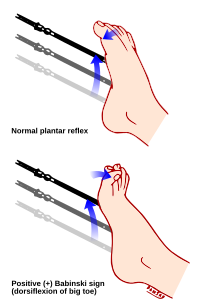
Photo from wikipedia
We aimed to analyse the relationship of peak torque (PT) of the knee extensors (Ext) and flexors (Fle) with age, and the relationship between conventional ratio and age progression in… Click to show full abstract
We aimed to analyse the relationship of peak torque (PT) of the knee extensors (Ext) and flexors (Fle) with age, and the relationship between conventional ratio and age progression in volleyball players. A total of 41 elite male volleyball players (age: 25.0 ± 6.1 years, body mass: 93.0 ± 9.8 kg, height: 198.0 ± 6.8 cm) were evaluated in a isokinetic dynamometer at speeds of 60, 180 and 300 deg/s, and at dominant (D) and non-dominant (ND) legs. In general, the knee flexor and extensor muscles varied greatly among the athletes (from 81 to 156 N.m for flexors; from 116 to 250 N.m for extensors at 300 deg/s and at dominant side). The mass-specific PT of knee extensors showed strong and negative correlation with ageing at 60 and 180 deg/s (r = -0.52-0.62, p < 0.01). The conventional ratio showed regular and positive relationship at all evaluated velocities (60°.s-1, r = 0.453, p < 0.01; 180°.s-1, r = 0.498, p < 0.01; 300°.s-1, r = 0.316, p = 0.04). The results demonstrated that volleyball players are susceptible to age-related effects on muscular performance during their career; this finding illustrates the importance of adopting training strategies to improve the production of strength in the lower limbs, which is essential for vertical jumps.
Journal Title: Sports biomechanics
Year Published: 2022
Link to full text (if available)
Share on Social Media: Sign Up to like & get
recommendations!